On this page
Communal and cooperative breedingThis page lists books about communal cooperative breeding The books are listed by publication date with the most recent at the top.
|
|
|
|
Helping And Communal Breeding in Birds: Ecology and EvolutionJerram L. Brown
Princeton Legacy Library
Princeton University Press
2014
This is a reprint of the original 1987 publication which was part of the series Monographs in Behavior and Ecology.
"An overview of the extensive and frequently controversial literature on communally breeding birds developed since the early 1960s, when students of evolution began to examine sociality as a product of natural selection. Jerram Brown provides original data from his own theoretical and empirical studies and summarizes the wide array of results and interpretations made by others." |
Buy from amazon.co.uk 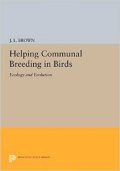
|
|
The Ostrich Communal Nesting SystemBrian C.R. Bertram
Princeton Legacy Library
Princeton University Press
2014
This is a reprint of the original 1992 publication which was part of the series Monographs in Behavior and Ecology.
"As the study of cooperative breeding systems expands, a number of key species form the examples that underpin our general understanding. The ostrich is increasingly becoming such a textbook species, on the basis of the results obtained in Brian Bertram's study of vigilance and egg discrimination in this extraordinary bird. Here Bertram presents new data on the ostrich communal nesting system, in which several females lay in one female's nest, with only one female and the male doing all the work."
|
Buy from amazon.co.uk 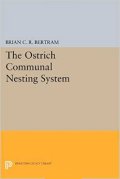
|
|
Ecology and Evolution of Cooperative Breeding in BirdsEditor: Walter Koenig and Janis Dickinson
Cambridge University Press
2004
"Cooperative breeders are species in which more than a pair of individuals assist in the production of young. Cooperative breeding is found in only a few hundred bird species world-wide, and understanding this often strikingly altruistic behaviour has remained an important challenge in behavioural ecology for over 30 years. This book highlights the theoretical, empirical and technical advances that have taken place in the field of cooperative breeding research since the publication of the seminal work Cooperative Breeding in Birds: Long-term Studies of Behavior and Ecology. Organized conceptually, special attention is given to ways in which cooperative breeders have proved fertile subjects for testing modern advances to classic evolutionary problems including those of sexual selection, sex-ratio manipulation, life-history evolution, partitioning of reproduction and incest avoidance. It will be of interest to both students and researchers interested in behaviour and ecology."
|
Buy from amazon.co.uk 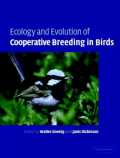
|
|
Helpers at Birds' Nests: A Worldwide Survey of Cooperative Breeding and Related BehaviorAlexander F. Skutch
University of Iowa Press
Expanded edition
1999
"Provides vivid, detailed accounts of a remarkable aspect of bird behavior - the aid that one bird gives another who is neither its mate nor its dependent young and who may even belong to a different species. Skutch describes the cooperative behavior of more than fifty families of birds. Each family is introduced by a brief sketch of its distribution and outstanding features, followed by intimate, nontechnical accounts of the helpful behaviors that have been most carefully studied. Skutch considers the significance of helpful birds and discusses the theoretical aspects of cooperative breeding, its evolution, kin selection, altruism, and demography."
|
Buy from amazon.co.uk 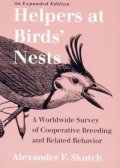
|
|
The Ostrich Communal Nesting SystemBrian C.R. Bertram
Monographs in Behavior and Ecology
Princeton University Press
1992
"As the study of co-operative breeding systems expands, a number of key species form the examples that underpin our general understanding. The ostrich is increasingly becoming such a textbook species, on the basis of the results obtained in Brian Bertram's study of vigilance and egg discrimination in this bird. Here, Bertram presents new data on the ostrich communal nesting system, in which several females lay in one female's nest, with only one female and the male doing all the work. His study unravels the basis of the co-operation observed, and explains how a system involving apparent altruism is maintained by natural selection. It is now possible as never before to explain and quantify the effects of the different choices these birds make and to integrate ecological and morphological factors such as predation and size. Based on three seasons of study in Tsavo West National Park in Kenya, the author recognizes individual birds, detects and monitors well-concealed nests, determines the motherhood of eggs from their surface appearance, and uses time-lapse photography of nests. Key findings are that females can switch rapidly between reproductive strategies, that a nesting female can recognize her own eggs and when necessary discriminate against those of other females, and that the whiteness of ostrich eggs is an adaptation that protects them against overheating but at the cost of greater vulnerability to predation."
|
Buy from amazon.co.uk 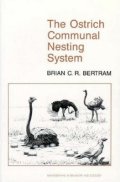
|
|
Cooperative Breeding in Birds: Long Term Studies of Ecology and BehaviourEditor: Peter B. Stacey and Walter D. Koenig
Cambridge University Press
1990
"Cooperative breeding is an unusual kind of social behaviour, found in a few hundred species worldwide, in which individuals other than the parents help raise young. Understanding the apparently altruistic behaviour of helpers has provided numerous challenges to evolutionary biologists. This book includes detailed first-hand summaries of many of the major empirical studies of cooperatively breeding birds. It provides comparative information on the demography, social behaviour and behavioural ecology of these unusual species and explores the diversity of ideas and the controversies which have developed in this field. The studies are all long-term and consequently the book summarises some of the most extensive studies of the behaviour of marked individuals ever undertaken. Graduate students and research workers in ornithology, sociobiology, behavioural ecology and evolutionary biology will find much of value in this book."
|
Buy from amazon.co.uk 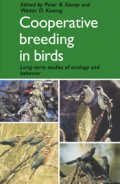
|
|
Helping And Communal Breeding in Birds: Ecology and EvolutionJerram L. Brown
Monographs in Behavior and Ecology
Princeton University Press
1987
|
Buy from amazon.co.uk 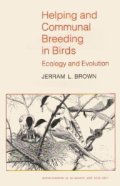
|
|
Population Ecology of the Cooperatively Breeding Acorn WoodpeckerWalter D. Koenig and Ronald L. Mumme
Monographs In Population Biology, Vol. 24
Princeton University Press
1987
"This study investigates the complexities of acorn storage and group living in acorn woodpeckers at Hastings Reservation in central coastal California."
|
Buy from amazon.co.uk 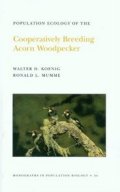
|
|
Helpers at Birds' Nests: A Worldwide Survey of Cooperative Breeding and Related BehaviorAlexander F. Skutch
University of Iowa Press
1987
Expanded edition published in 1999.
|
Buy from amazon.co.uk 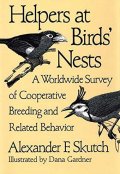
|
|
The Florida Scrub Jay: Demography Of A Cooperative-Breeding BirdGlen E Woolfenden, John W. Fitzpatrick
Monographs In Population Biology, Vol. 20
Princeton University Press
1985
"Florida Scrub Jays are an excellent example of a cooperative-breeding species, in which adult birds often help raise offspring not their own. For more than a decade Glen E. Woolfenden and John W. Fitzpatrick studied a marked population of these birds in an attempt to establish a demographic base for understanding the phenomenon of "helping at the nest." By studying both population biology and behavior, the authors found that habitat restraints, rather than kin selection, are the main source of the behavior of Florida Scrub Jays: the goal of increasing the number of close relatives other than descendants in future generations is of relatively minor importance in their cooperative-breeding behavior. The Florida Scrub Jay lives only in the Florida oak scrub. All acceptable habitat is constantly filled with breeders. Each year about half of the pairs are assisted by one to several nonbreeding helpers. This book provides extensive data on fecundity, survivorship, relatedness, and dispersal to establish the demographic milieu and to address questions arising out of observed helping behavior - whom, how, when, and why the helpers help."
|
Buy from amazon.co.uk 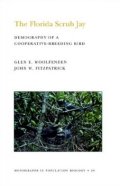
|
|